Related Research Articles

The Jamestown settlement in the Colony of Virginia was the first permanent English settlement in the Americas. It was located on the northeast bank of the James River, about 2.5 mi (4 km) southwest of the center of modern Williamsburg. It was established by the Virginia Company of London as "James Fort" on May 4, 1607 O.S., and was considered permanent after a brief abandonment in 1610. It followed several failed attempts, including the Lost Colony of Roanoke, established in 1585 on Roanoke Island, later part of North Carolina. Jamestown served as the colonial capital from 1616 until 1699. Despite the dispatch of more settlers and supplies, more than 80 percent of the colonists died in 1609–1610, mostly from starvation and disease. In mid-1610, the survivors abandoned Jamestown, though they returned after meeting a resupply convoy in the James River.

Powhatan County is a county located in the Commonwealth of Virginia. As of the 2020 census, the population was 30,033. Its county seat is Powhatan.

The Colony of Virginia was an English, later British, colonial settlement in North America between 1606 and 1776.
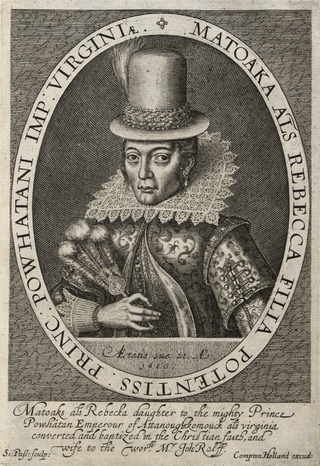
Pocahontas was a Native American woman belonging to the Powhatan people, notable for her association with the colonial settlement at Jamestown, Virginia. She was the daughter of Powhatan, the paramount chief of a network of tributary tribes in the Tsenacommacah, encompassing the Tidewater region of what is today the U.S. state of Virginia.

John Rolfe was an English explorer, farmer and merchant. He is best known for being the husband of Pocahontas and the first settler in the colony of Virginia to successfully cultivate a tobacco crop for export.

The Powhatan people (;) are Native Americans who belong to member tribes of the Powhatan Confederacy, or Tsenacommacah. They are Algonquian peoples whose historic territories were in eastern Virginia.

Opechancanough was paramount chief of the Powhatan Confederacy in present-day Virginia from 1618 until his death. He had been a leader in the confederacy formed by his older brother Powhatan, from whom he inherited the paramountcy.
In the seventeenth century, Kecoughtan was the name of the settlement now known as Hampton, Virginia, In the early twentieth century, it was also the name of a town nearby in Elizabeth City County. It was annexed into the City of Newport News in 1927.

Powhatan, whose proper name was Wahunsenacawh, was the leader of the Powhatan, an alliance of Algonquian-speaking Native Americans living in Tsenacommacah, in the Tidewater region of Virginia at the time when English settlers landed at Jamestown in 1607.
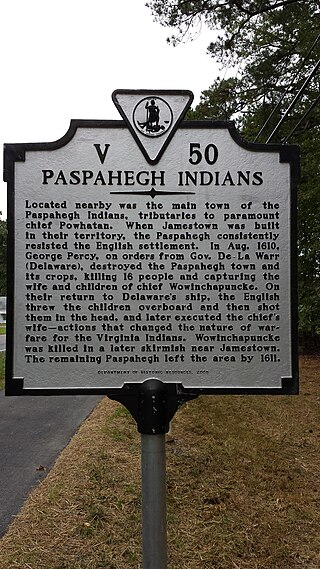
The Paspahegh tribe was a Native American tributary to the Powhatan paramount chiefdom, incorporated into the chiefdom around 1596 or 1597. The Paspahegh Indian tribe lived in present-day Charles City and James City counties, Virginia. The Powhatan Confederacy included Indigenous peoples of the Northeastern Woodlands who spoke a related Eastern Algonquian languages.
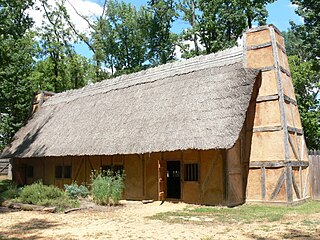
The "Citie of Henricus"—also known as Henricopolis, Henrico Town or Henrico—was a settlement in Virginia founded by Sir Thomas Dale in 1611 as an alternative to the swampy and dangerous area around the original English settlement at Jamestown, Virginia. It was named for Henry, Prince of Wales (1594–1612), the eldest son of King James I.
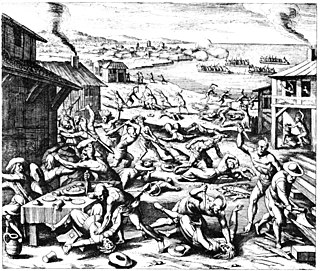
The Indian massacre of 1622 took place in the English colony of Virginia on 22 March 1622. English explorer John Smith, though he was not an eyewitness, wrote in his History of Virginia that warriors of the Powhatan "came unarmed into our houses with deer, turkeys, fish, fruits, and other provisions to sell us"; they then grabbed any tools or weapons available and killed all English settlers they found, including men, women, and children of all ages. Opechancanough, chief of the Powhatan Confederacy, led a coordinated series of surprise attacks that ended up killing a total of 347 people — a quarter of the population of the Colony of Virginia.

The Pamunkey Indian Tribe is one of 11 Virginia Indian tribal governments recognized by the Commonwealth of Virginia, and the state's first federally recognized tribe, receiving its status in January 2016. Six other Virginia tribal governments, the Chickahominy, the Eastern Chickahominy, the Upper Mattaponi, the Rappahannock, the Monacan, and the Nansemond, were similarly recognized through the passage of the Thomasina E. Jordan Indian Tribes of Virginia Federal Recognition Act of 2017 on January 12, 2018. The historical people were part of the Powhatan paramountcy, made up of Algonquian-speaking nations. The Powhatan paramount chiefdom was made up of over 30 nations, estimated to total about 10,000–15,000 people at the time the English arrived in 1607. The Pamunkey nation made up about one-tenth to one-fifteenth of the total, as they numbered about 1,000 persons in 1607.

Werowocomoco was a village that served as the headquarters of Chief Powhatan, a Virginia Algonquian political and spiritual leader when the English founded Jamestown in 1607. The name Werowocomoco comes from the Powhatan werowans (weroance), meaning "leader" in English; and komakah (-comoco), "settlement". The town was documented by English settlers in 1608 as located near the north bank of the York River in what is now Gloucester County. It was separated by that river and the narrow Virginia Peninsula from the English settlement of Jamestown, located on the James River.

The Rappahannock are a federally recognized tribe in Virginia and one of the eleven state-recognized tribes. They are made up of descendants of several small Algonquian-speaking tribes who merged in the late 17th century. In January 2018, they were one of six Virginia tribes to gain federal recognition by passage of the Thomasina E. Jordan Indian Tribes of Virginia Federal Recognition Act of 2017.
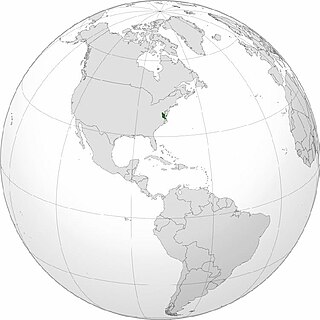
Tsenacommacah is the name given by the Powhatan people to their native homeland, the area encompassing all of Tidewater Virginia and parts of the Eastern Shore. More precisely, its boundaries spanned 100 miles (160 km) by 100 miles (160 km) from near the south side of the mouth of the James River all the way north to the south end of the Potomac River and from the Eastern Shore west to about the Fall Line of the rivers.
Elizabeth City was one of four incorporations established in the Virginia Colony in 1619 by the proprietor, the Virginia Company of London, acting in accordance with instructions issued by Sir George Yeardley, Governor. This allowed the crown to benefit from the offerings of the new land, including its natural resources, new markets for English goods, and the leverage it provided against the Spanish.

The Anglo–Powhatan Wars were three wars fought between settlers of the Colony of Virginia and the Powhatan People of Tsenacommacah in the early 17th century. The first war started in 1609 and ended in a peace settlement in 1614. The second war lasted from 1622 to 1632. The third war lasted from 1644 until 1646 and ended when Opechancanough was captured and killed. That war resulted in a defined boundary between the Indians and colonial lands that could only be crossed for official business with a special pass. This situation lasted until 1677 and the Treaty of Middle Plantation which established Indian reservations following Bacon's Rebellion.

Jamestown, also Jamestowne, was the first settlement of the Virginia Colony, founded in 1607, and served as the capital of Virginia until 1699, when the seat of government was moved to Williamsburg. This article covers the history of the fort and town at Jamestown proper, as well as colony-wide trends resulting from and affecting the town during the time period in which it was the colonial capital of Virginia.

Opossunoquonuske, was a Weroansqua of an Appomattoc town near the mouth of the Appomattox River. Weroansqua is an Algonquian word meaning leader or commander among the Powhatan confederacy of Virginia coast and Chesapeake Bay region. She was known as the queen of Appamatuck, The community she led was large enough to provide an estimated twenty warriors to the Powhatan Confederacy.
References
- 1 2 3 4 Rountree, Helen C. "Ashuaquid (fl. 1607)". Encyclopedia Virginia. Retrieved 26 August 2015.
- ↑ Frank E. Grizzard; Daniel Boyd Smith (2007). The Jamestown Colony: An Encyclopedia. ABC-CLIO. p. 37. ISBN 978-1-85109-637-4 . Retrieved 14 November 2012.
- ↑ "History Predating Most Of The Country". About Henrico. Henrico County Virginia. Archived from the original on 12 November 2012. Retrieved 14 November 2012.
- ↑ Earl Swift (1 May 2002). Journey on the James: Three Weeks Through the Heart of Virginia. Journey on the James: Three Weeks through the Heart of Virginia. pp. 163–164. ISBN 978-0-8139-2119-8 . Retrieved 14 November 2012.
- ↑ Horn, James (2008). A Land As God Made It: Jamestown and the Birth of America. New York: Basic Books. p. 52. ISBN 9780786721986.